| Revision as of 21:17, 2 April 2014 editApokryltaros (talk | contribs)Autopatrolled, Extended confirmed users, Pending changes reviewers, Rollbackers79,990 edits Reverted 1 edit by 12.130.161.8 (talk): Please provide a reference to support your claim that seahorses aren't used as "medicine" in "Traditional Chinese Medicine". (TW)← Previous edit | Revision as of 21:41, 2 April 2014 edit undoApokryltaros (talk | contribs)Autopatrolled, Extended confirmed users, Pending changes reviewers, Rollbackers79,990 edits →Use in Chinese medicineNext edit → | ||
| Line 102: | Line 102: | ||
| ==Use in Chinese medicine== | ==Use in Chinese medicine== | ||
| ] | ] | ||
| Seahorse populations are thought to have been ] in recent years by overfishing and habitat destruction. The seahorse is used as a medicine in traditional ] primarily for the treatment of ], wheezing, ], and pain,<ref name=Bensky>Bensky, D., Clavey, S., Stoger, E. (3rd edition 2004) Materia Medica Eastland Press, Inc. Seattle, p 815</ref> |
Seahorse populations are thought to have been ] in recent years by overfishing and habitat destruction. The seahorse is used as a medicine in traditional ] primarily for the treatment of ], wheezing, ], and pain, as well as ].<ref name=Bensky>Bensky, D., Clavey, S., Stoger, E. (3rd edition 2004) Materia Medica Eastland Press, Inc. Seattle, p 815</ref> Up to 20 million seahorses may be caught each year and sold for use in ].<ref> on ''Nova'' television show</ref> Despite a lack of scientific studies, their consumption for medicinal purposes is widespread. The preferred species of medicinal seahorses, such as ''H. kellogii, H. histrix, H. kuda, H. trimaculatus,'' and ''H. japonicus''<ref name=Bensky /> are not readily bred in captivity as they are susceptible to disease,{{cn|date=March 2014}} and wild-caught seahorses are perceived by users to have greater potency than aquarium seahorses.{{cn|date=March 2014}} Seahorses are also consumed by the Indonesians, the Central Filipinos, and many other ethnic groups. | ||
| Import and export of seahorses has been controlled under ] since 15 May 2004. However, ], ], ], and ] have chosen to opt out of the trade rules set by CITES.<!--dead <ref> | Import and export of seahorses has been controlled under ] since 15 May 2004. However, ], ], ], and ] have chosen to opt out of the trade rules set by CITES.<!--dead <ref> | ||
Revision as of 21:41, 2 April 2014
This article is about the genus of fish. For the mythological sea-horse, see hippocamp. For other uses, see seahorse (disambiguation).
| Seahorses Temporal range: 23–0 Ma PreꞒ Ꞓ O S D C P T J K Pg N Lower Miocene to Present | |
|---|---|
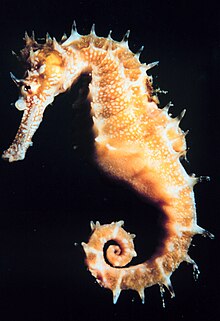
| |
| Hippocampus sp. | |
| Scientific classification | |
| Kingdom: | Animalia |
| Phylum: | Chordata |
| Class: | Actinopterygii |
| Order: | Syngnathiformes |
| Family: | Syngnathidae |
| Subfamily: | Hippocampinae |
| Genus: | Hippocampus Rafinesque, 1810 |
| Species | |
|
see Species. | |
Seahorse is the title given to 54 species of marine fish in the genus Hippocampus. "Hippocampus" comes from the Ancient Greek hippos meaning "horse" and kampos meaning "sea monster".
Habitat
Seahorses are mainly found in shallow tropical and temperate waters throughout the world, and prefer to live in sheltered areas such as seagrass beds, estuaries, coral reefs, or mangroves. In Pacific waters from North America to South America there are four species. In the Atlantic, the H. erectus ranges from Nova Scotia to Uruguay. H. zosterae, known as the dwarf seahorse, is found in the Bahamas.
Colonies have been found in European waters such as the Thames Estuary.
Three species live in the Mediterranean Sea: H. guttulatus (the long-snouted seahorse), H. hippocampus (the short-snouted seahorse) and H. fuscus (the sea pony). These species form territories; males stay within 1 square meter (11 sq ft) of their habitat while females range about one hundred times that.
Physical description
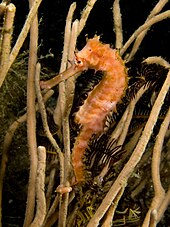
Seahorses range in size from 1.5 to 35.5 cm (0.6 to 14.0 in). They are named for their equine appearance. Although they are bony fish, they do not have scales but rather thin skin stretched over a series of bony plates, which are arranged in rings throughout their body. Each species has a distinct number of rings. Seahorses swim upright, another characteristic that is not shared by their close pipefish relatives, who swim horizontally. Razorfish are the only other fish that swim vertically like a seahorse. Unusual among fish, seahorses have a flexible, well-defined neck. They also sport a coronet on the head, which is distinct for each individual.
Seahorses swim very poorly, rapidly fluttering a dorsal fin and using pectoral fins (located behind their eyes) to steer. The slowest-moving fish in the world is H. zosterae (the dwarf seahorse), with a top speed of about 1.5 metres (5 ft) per hour. Seahorses have no caudal fin. Since they are poor swimmers, they are most likely to be found resting with their prehensile tails wound around a stationary object. They have long snouts, which they use to suck up food, and eyes that can move independently of each other (like those of a chameleon).
Evolution and fossil record
Anatomical evidence, supported by molecular, physical, and genetic evidence, demonstrates that seahorses are highly modified pipefish. The fossil record of seahorses, however, is very sparse. The best known and best studied fossils are specimens of H. guttulatus (though literature more commonly refers to them under the synonym of H. ramulosus), from the Marecchia River Formation of Rimini Province, Italy, dating back to the Lower Pliocene, about 3 million years ago. The earliest known seahorse fossils are of two pipefish-like species, H. sarmaticus and H. slovenicus from the coprolitic horizon of Tunjice Hills, a middle Miocene lagerstätte in Slovenia dating back about 13 million years. Molecular dating finds that pipefish and seahorses separated during the Late Oligocene. This has led to speculation that seahorses evolved in response to large areas of shallow-water, newly created as the result of tectonic events. The shallow water allowed the expansion of seagrass habitats that selected for the camouflage offered by the seahorses’ upright posture. These tectonic changes occurred in the Western Pacific Ocean suggesting an origin there with molecular data suggesting two later and separate invasions of the Atlantic Ocean.
Reproduction

The male seahorse is equipped with a brood pouch on the ventral, or front-facing, side of the tail. When mating, the female seahorse deposits up to 1,500 eggs in the male's pouch. The male carries the eggs for 9 to 45 days until the seahorses emerge fully developed, but very small. Once the seahorses are released into the water, the male's role is done and he offers no further care and often mates again within hours or days during the breeding season.
Courtship
Before breeding, seahorses may court for several days. Scientists believe the courtship behavior synchronizes the animals' movements as well as reproductive state so that the male can receive the eggs when the female is ready to deposit them. During this time they may change color, swim side by side holding tails or grip the same strand of sea grass with their tails and wheel around in unison in what is known as a “pre-dawn dance". They eventually engage in a “true courtship dance" lasting about 8 hours, during which the male pumps water through the egg pouch on his trunk which expands and opens to display its emptiness. When the female’s eggs reach maturity, she and her mate let go of any anchors and snout-to-snout, drift upward out of the seagrass, often spiraling as they rise. The female inserts her ovipositor into the male’s brood pouch and deposits dozens to thousands of eggs. As the female releases her eggs, her body slims while his swells. Both animals then sink back into the seagrass and she swims away.
Gestation
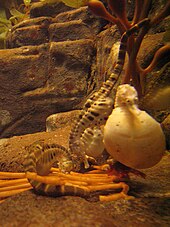
The male releases his sperm directly into seawater where it fertilizes the eggs, which are then embedded in the pouch wall and become surrounded by a spongy tissue. The male supplies the eggs with prolactin, the same hormone responsible for milk production in pregnant mammals. The pouch provides oxygen as well as a controlled environment incubator. The eggs then hatch in the pouch where the salinity of the water is regulated; this prepares the newborns for life in the sea. Throughout gestation, which in most species requires two to four weeks, his mate visits him daily for “morning greetings”. They interact for about 6 minutes, reminiscent of courtship. The female then swims away until the next morning, and the male returns to sucking up food through his snout.
Research published in 2007 indicates the male releases sperm into the surrounding sea water during fertilization, and not directly into the pouch as previously thought.
Birth
The number of young released by the male seahorse averages 100–1000 for most species, but may be as low as 5 for the smaller species, or as high as 2,500. When the fry are ready to be born, the male expels them with muscular contractions. He typically gives birth at night and is ready for the next batch of eggs by morning when his mate returns. Like almost all other fish species, seahorses do not nurture their young after birth. Infants are susceptible to predators or ocean currents which wash them away from feeding grounds or into temperatures too extreme for their delicate bodies. Less than 0.5% of infants survive to adulthood, explaining why litters are so large. These survival rates are actually fairly high compared to other fish, because of their protected gestation, making the process worth the great cost to the father. The eggs of most other fish are abandoned immediately after fertilization.
Questions surrounding reproductive roles
Reproduction is energetically costly to the male. This brings into question why the sexual role reversal even takes place. In an environment where one partner incurs more energy costs than the other, Bateman's principle suggests that the lesser contributor takes the role of the aggressor. Male seahorses are more aggressive and sometimes “fight” for female attention. According to Amanda Vincent of Project Seahorse, only males tail-wrestle and snap their heads at each other. This discovery prompted further study of energy costs. To estimate the female’s direct contribution, researcher Heather D. Masonjones, associate professor of biology at the University of Tampa, chemically analyzed the energy stored in each egg. To measure the burden on the male, Masonjones measured its oxygen consumption. By the end of incubation, the male consumed almost 33% more oxygen than before mating. The study concluded that the female's energy expenditure while generating eggs is twice that of males during incubation confirming the standard hypothesis.
Why the male seahorse (and other members of Syngnathidae) carries the offspring through gestation is unknown, though some researchers believe it allows for shorter birthing intervals, in turn resulting in more offspring. Given an unlimited number of ready and willing partners, males have the potential to produce 17 percent more offspring than females in a breeding season. Also, females have “time-outs” from the reproductive cycle that are 1.2 times longer than those of males. This seems to be based on mate choice, rather than physiology. When the female’s eggs are ready, she must lay them in a few hours or eject them into the water column. Making eggs is a huge cost to her physically, since they amount to about a third of her body weight. To protect against losing a clutch, the female demands a long courtship. The daily greetings help to cement the bond between the pair.
Monogamy
One common misconception about seahorses is that they mate for life. Many species of seahorses form pair bonds that last through at least the breeding season. Some species show a higher level of mate fidelity than others. However, many species readily switch mates when the opportunity arises. H. abdominalis and H. breviceps have been shown to breed in groups, showing no continuous mate preference. Many more species mating habits have not been studied, so it is unknown how many species are actually monogamous, or how long those bonds actually last.
Although monogamy within fish is not common, it does appear to exist for some. In this case, the mate guarding hypothesis may be an explanation. This hypothesis states “males remain with a single female because of ecological factors that make male parental care and protection of offspring especially advantageous.” Because the rates of survival for newborn seahorses are so low, incubation is essential. Though not proven, males could have taken on this role because of the lengthy period the females require to produce their eggs. If males incubate while females prepare the next clutch (amounting to 1/3 of body weight), they can reduce the interval between clutches.
Feeding habits
Seahorses feed on small crustaceans floating in the water or crawling on the bottom. With excellent camouflage and a lot of patience, seahorses ambush prey that float within striking range. Mysid shrimp and other small crustaceans are favorites, but some seahorses have been observed eating other kinds of invertebrates and even larval fish. While feeding, they produce a distinctive click each time a food item is ingested. The same clicks are heard with social interactions. In a study of seahorses, it was determined that the distinctive head shape gives rise to a space that is met with minimal interference. Therefore, the seahorse has the ability to come within a very close range of copepods, which they prey on.
Threats of extinction

Many seahorse species are data deficient, and there is insufficient information to make an assessment about their risk of extinction. Because the seahorse population is unknown, there is a risk of losing more seahorses because of the lack of information about how many are dying each year, how many are being born, the number used for souvenirs, etc. Coral reefs and seagrass beds are deteriorating, reducing viable habitats for seahorses.
Aquaria
While many aquarium hobbyists keep seahorses as pets, seahorses collected from the wild tend to fare poorly in home aquaria. Many eat only live foods such as brine shrimp and are prone to stress, which damages their immune systems and makes them susceptible to disease.

In recent years, however, captive breeding has become more popular. Such seahorses survive better in captivity, and are less likely to carry diseases. They eat frozen mysidacea (crustaceans) that are readily available from aquarium stores, and do not experience the stress of moving out of the wild. Although captive-bred seahorses are more expensive, they take no toll on wild populations.
Seahorses should be kept in an aquarium with low flow and placid tank mates. Seahorses are slow feeders, so fast, aggressive feeders will leave them without food.
Seahorses can co-exist with many species of shrimp and other bottom-feeding creatures. Gobies also make good tank-mates. Keepers are generally advised to avoid eels, tangs, triggerfish, squid, octopus, and sea anemones.
Water quality is very important for the survival of seahorses in an aquarium. Seahorses are delicate species which should not be added to a new tank. The water parameters are recommended to be as follows although these fish may acclimatise to different water over time: Temperature: 23-28 °C pH: 8.1-8.4 Ammonia: 0 mg/l (0.01 mg/l may be tolerated for short periods) Nitrite: 0 mg/l (0.125 mg/l may be tolerated for short periods) S.G.: 1.021-1.024 at 22-24 °C A water quality problem will affect fish behaviour and can be shown by clamped fins, reduced feeding, erratic swimming and gasping at the surface
Seahorses swim up and down as well as utilising the length of the aquarium. Therefore, the tanks should ideally be twice as deep as the length of the adult seahorse.
Animals sold as "freshwater seahorses" are usually the closely related pipefish, of which a few species live in the lower reaches of rivers. The supposed true "freshwater seahorse" called H. aimei was not a real species, but a name sometimes used for Barbour's and Hedgehog seahorses. The latter is a species that can be found in brackish waters, but not actually a freshwater fish.
Use in Chinese medicine
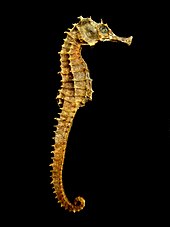
Seahorse populations are thought to have been endangered in recent years by overfishing and habitat destruction. The seahorse is used as a medicine in traditional Chinese herbology primarily for the treatment of impotence, wheezing, nocturnal enuresis, and pain, as well as to promote labor. Up to 20 million seahorses may be caught each year and sold for use in Traditional Chinese Medicine. Despite a lack of scientific studies, their consumption for medicinal purposes is widespread. The preferred species of medicinal seahorses, such as H. kellogii, H. histrix, H. kuda, H. trimaculatus, and H. japonicus are not readily bred in captivity as they are susceptible to disease, and wild-caught seahorses are perceived by users to have greater potency than aquarium seahorses. Seahorses are also consumed by the Indonesians, the Central Filipinos, and many other ethnic groups.
Import and export of seahorses has been controlled under CITES since 15 May 2004. However, Indonesia, Japan, Norway, and South Korea have chosen to opt out of the trade rules set by CITES.
The problem may be exacerbated by the growth of pills and capsules as the preferred method of ingesting seahorses. They are cheaper and more available than traditional, individually tailored prescriptions of whole seahorses, but the contents are harder to track. Seahorses once had to be of a certain size and quality before they were accepted by TCM practitioners and consumers. Declining availability of the preferred large, pale and smooth seahorses has been offset by the shift towards prepackaged preparations, which make it possible for TCM merchants to sell previously unused juvenile, spiny and dark-coloured animals. Today almost a third of the seahorses sold in China are prepackaged, adding to the pressure on the species.
Dried seahorses retails from US$600 – 3000 per kilogram with larger, paler and smoother animals commanding the highest prices. In fact, in terms of value based on weight seahorses retail for more than the price of silver and almost that of gold in Asia. (UNEP,2004).
Species
There are currently 54 recognized species in this genus:

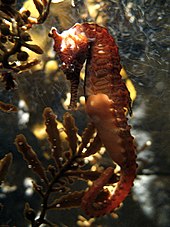

- Hippocampus abdominalis Lesson, 1827 (Big-belly seahorse)
- Hippocampus alatus Kuiter, 2001 (Winged seahorse)
- Hippocampus algiricus Kaup, 1856 (West African seahorse)
- Hippocampus angustus Günther, 1870 (Narrow-bellied seahorse)
- Hippocampus barbouri D. S. Jordan & R. E. Richardson, 1908 (Barbour's seahorse)
- Hippocampus bargibanti Whitley, 1970 (Pygmy seahorse)
- Hippocampus biocellatus Kuiter, 2001 (False-eyed seahorse)
- Hippocampus borboniensis A. H. A. Duméril, 1870 (Réunion seahorse)
- Hippocampus breviceps W. K. H. Peters, 1869 (Short-headed seahorse)
- Hippocampus camelopardalis Bianconi, 1854 (Giraffe seahorse)
- Hippocampus capensis Boulenger, 1900 (Knysna seahorse)
- Hippocampus colemani Kuiter, 2003
- Hippocampus comes Cantor, 1850 (Tiger tail seahorse)
- Hippocampus coronatus Temminck & Schlegel, 1850 (Crowned seahorse)
- Hippocampus curvicuspis R. Fricke, 2004 (New Caledonian thorny seahorse)
- Hippocampus debelius M. F. Gomon & Kuiter, 2009 (Softcoral seahorse)
- Hippocampus denise Lourie & J. E. Randall, 2003 (Denise's pygmy seahorse)
- Hippocampus erectus Perry, 1810 (Lined seahorse)
- Hippocampus fisheri D. S. Jordan & Evermann, 1903 (Fisher's seahorse)
- Hippocampus fuscus Rüppell, 1838 (Sea pony)
- Hippocampus grandiceps Kuiter, 2001 (Big-head seahorse)
- Hippocampus guttulatus G. Cuvier, 1829 (Long-snouted seahorse)
- Hippocampus hendriki Kuiter, 2001 (Eastern spiny seahorse)
- Hippocampus hippocampus (Linnaeus, 1758) (Short-snouted seahorse)
- Hippocampus histrix Kaup, 1856 (Spiny seahorse)
- Hippocampus ingens Girard, 1858 (Pacific seahorse)
- Hippocampus jayakari Boulenger, 1900 (Jayakar's seahorse)
- Hippocampus jugumus Kuiter, 2001 (Collared seahorse)
- Hippocampus kelloggi D. S. Jordan & Snyder, 1901 (Great seahorse)
- Hippocampus kuda Bleeker, 1852 (Spotted seahorse)
- Hippocampus lichtensteinii Kaup, 1856 (Lichtenstein's seahorse)
- Hippocampus minotaur M. F. Gomon, 1997 (Bullneck seahorse)
- Hippocampus mohnikei Bleeker, 1854 (Japanese seahorse)
- Hippocampus montebelloensis Kuiter, 2001 (Monte Bello seahorse)
- Hippocampus multispinus Kuiter, 2001 (Northern spiny seahorse)
- Hippocampus paradoxus Foster & M. F. Gomon, 2010 (Paradoxical seahorse)
- Hippocampus patagonicus Piacentino & Luzzatto, 2004
- Hippocampus pontohi Lourie & Kuiter, 2008
- Hippocampus procerus Kuiter, 2001 (High-crown seahorse)
- Hippocampus pusillus R. Fricke, 2004 (Pygmy thorny seahorse)
- Hippocampus queenslandicus Horne, 2001 (Queensland seahorse)
- Hippocampus reidi Ginsburg, 1933 (Longsnout seahorse)
- Hippocampus satomiae Lourie & Kuiter, 2008 (Satomi's pygmy seahorse)
- Hippocampus semispinosus Kuiter, 2001 (Half-spined seahorse)
- Hippocampus severnsi Lourie & Kuiter, 2008
- Hippocampus sindonis D. S. Jordan & Snyder, 1901 (Dhiho's seahorse)
- Hippocampus spinosissimus M. C. W. Weber, 1913 (Hedgehog seahorse)
- Hippocampus subelongatus Castelnau, 1873 (West Australian seahorse)
- Hippocampus trimaculatus Leach, 1814 (Longnose seahorse)
- Hippocampus tyro J. E. Randall & Lourie, 2009
- Hippocampus waleananus M. F. Gomon & Kuiter, 2009 (Walea Pygmy seahorse)
- Hippocampus whitei Bleeker, 1855 (White's seahorse)
- Hippocampus zebra Whitley, 1964 (Zebra seahorse)
- Hippocampus zosterae D. S. Jordan & C. H. Gilbert, 1882 (Dwarf seahorse)

Pygmy seahorses
Main article: HippocampinaePygmy seahorses are less than 15 millimeters (0.59 in) tall and 17 millimeters (0.67 in) wide members of the genus. Previously the term was applied exclusively to the species H. bargibanti but since 1997, discoveries have made this term obsolete. The species H. minotaur, H. denise, H. colemani, H. pontohi, H. severnsi and H. satomiae have been described. Other species that are believed to be unclassified have also been reported in books, dive magazines and on the Internet. They can be distinguished from other species of seahorse by their 12 trunk rings, low number of tail rings (26–29), the location in which young are brooded in the trunk region of males and their extremely small size. Molecular analysis (of ribosomal RNA) of 32 Hippocampus species found that H. bargibanti belongs in a separate clade from other members of the genus and therefore that the species diverged from the other species in the "ancient" past.
Most pygmy seahorses are well camouflaged and live in close association with other organisms including colonial hydrozoans (Lytocarpus and Antennellopsis), coralline algae (Halimeda) sea fans (Muricella, Annella, Acanthogorgia). This combined with their small size accounts for why most species have only been noticed and classified since 2001.
References
- Hippocampus Rafinesque, 1810, WoRMS
- Duvernoy, HM (2005). "Introduction". The Human Hippocampus (3rd ed.). Berlin: Springer-Verlag. p. 1. ISBN 3-540-23191-9.
{{cite book}}: External link in|chapterurl=|chapterurl=ignored (|chapter-url=suggested) (help) - "Rare seahorses breeding in Thames". BBC News. 7 April 2008. Retrieved 11 November 2009.
- "Seahorses, Seahorse Pictures, Seahorse Facts". National Geographic. Retrieved 17 May 2012.
- Guinness Book of World Records (2009)
- Žalohar J., Hitij T., Križnar M. (2009). "Two new species of seahorses (Syngnathidae, Hippocampus) from the Middle Miocene (Sarmatian) Coprolitic Horizon in Tunjice Hills, Slovenia: The oldest fossil record of seahorses". Annales de Paléontologie. 95 (2): 71–96. doi:10.1016/j.annpal.2009.03.002.
{{cite journal}}: CS1 maint: multiple names: authors list (link) - Teske PR, Beheregaray LB (2009). "Evolution of seahorses' upright posture was linked to Oligocene expansion of seagrass habitats". Biol Lett. 5 (4): 521–3. doi:10.1098/rsbl.2009.0152. PMC 2781918. PMID 19451164.
-
Teske PR, Cherry MI, Matthee CA (2004). "The evolutionary history of seahorses (Syngnathidae: Hippocampus): molecular data suggest a West Pacific origin and two invasions of the Atlantic Ocean". Mol Phylogenet Evol. 30 (2): 273–86. doi:10.1016/S1055-7903(03)00214-8. PMID 14715220.
{{cite journal}}: CS1 maint: multiple names: authors list (link) - Foster S.J, Vincent C.J. (2004). "Life history and ecology of seahorses: implications for conservation and management". Journal of Fish Biology. 65: 1–61. doi:10.1111/j.1095-8649.2004.00429.x.
- Sex and the seahorse. independent.co.uk
- "The biology of seahorses: Reproduction". The Seahorse Project. Retrieved 8 May 2007.
- ^ Milius, Susan (2000). "Pregnant—and Still Macho - seahorses | Science News | Find Articles at BNET.com". Findarticles.com. Retrieved 11 November 2009.
- ^ "Seahorse Fathers Take Reins in Childbirth". News.nationalgeographic.com. Retrieved 11 November 2009.
- Connor, Steve (19 January 2007). "Sex and the seahorse". London: The Independent. Retrieved 11 November 2009.
- Vincent, Amanda C. J. (1994). "Operational Sex Ratios in Seahorses". Behaviour. 128 (1/2): 153–167. doi:10.1163/156853994X00091. JSTOR 4535169.
- "Why Do Male Seahorses Get Pregnant?". Petseahorse.com.
- Kvarnemo C, Moore G.I, Jones A.G, Nelson W.S, Avise J.C. (2000). "Monogamous pair bonds and mate switching in the Western Australian seahorse Hippocampus subelongatus". J. Evol. Biol. 13 (6): 882–8. doi:10.1046/j.1420-9101.2000.00228.x.
{{cite journal}}: CS1 maint: multiple names: authors list (link) - Vincent C.J., Sadler L.M. (1995). "Faithful pair bonds in wild seahorses, Hippocampus whitei" (PDF). Anim. Behav. 50 (6): 1557–1569. doi:10.1016/0003-3472(95)80011-5.
- "What's Love Got to Do With It? The Truth About Seahorse Monogamy". fusedjaw.com.
- Alcock, John (2005). Animal Behavior (8th ed.). Massachusetts: Sinauer. pp. 370–1. ISBN 0878930051.
- http://newswatch.nationalgeographic.com/2013/11/26/why-does-the-seahorse-have-its-odd-head-mystery-solved/
- Lourie, Sarah A.; Foster, Sarah J.; Cooper, Ernest W.T. and Vincent, Amanda C.J. (2004) A Guide to the Identification of Seahorses. Project Seahorse Advancing Marine Conservation, ISBN 0-89164-169-6.
- ^ "Seahorse and Pipefish Foods | Tami Weiss". Fusedjaw.com. 25 June 2005. Retrieved 11 November 2009.
- "Seahorse Tankmates | Will Wooten". Fusedjaw.com. 25 June 2004. Retrieved 11 November 2009.
- http://www.seahorseaquariums.ie/info/27%20How%20to%20care%20for%20Seahorses%20&%20Pipefish.pdf
- "Hippocampus spinosissimus". Fishbase. Retrieved 11 November 2009.
- ^ Bensky, D., Clavey, S., Stoger, E. (3rd edition 2004) Materia Medica Eastland Press, Inc. Seattle, p 815
- "Seahorse Crusader Amanda Vincent" on Nova television show
- Parry-Jones, Rob and Vincent, Amanda (3 January 1998). "Can we tame wild medicine?". New Scientist.
{{cite web}}: CS1 maint: multiple names: authors list (link) - http://www.saveourseahorses.org/the-seahorse-dilemma.php
- Froese, Rainer; Pauly, Daniel (eds.). "Species in genus Hippocampus". FishBase. October 2012 version.
- ^ Lourie, Sara (2008). "Three new pygmy seahorse species from Indonesia (Teleostei: Syngnathidae: Hippocampus)" (PDF). Zootaxa. 1963: 54–68. ISSN 1175-5334. Retrieved 9 June 2009.
{{cite journal}}: Unknown parameter|coauthors=ignored (|author=suggested) (help) - Teske, Peter (February 2004). "The evolutionary history of seahorses (Syngnathidae: Hippocampus): molecular data suggest a West Pacific origin and two invasions of the Atlantic Ocean". Molecular Phylogenetics and Evolution. 30 (2): 273–286. doi:10.1016/S1055-7903(03)00214-8. PMID 14715220.
{{cite journal}}: Unknown parameter|coauthors=ignored (|author=suggested) (help) - "Science in Pictures: Pygmy Seahorses." The Epoch Times, Northern California Edition (8 November 2011).
Further reading
- Amanda C.J. Vincent and Laila M. Sadler (1995). "Faithful pair bonds in wild seahorse, Hippocampus whitei". Animal Behaviour. 50 (6): 1557–69. doi:10.1016/0003-3472(95)80011-5.
- Amanda C.J. Vincent (1995). "A role for daily greetings in maintaining seahorse pair bonds". Animal Behaviour. 49: 258–260. doi:10.1016/0003-3472(95)80178-2.
- Amanda C.J. Vincent (1990). "A seahorse father makes a good mother". Natural History. 12: 34–43.
- Amanda C.J. Vincent and Rosie Woodroffe (1994). "Mothers little helpers: patterns of male care in mammals". Trends in Ecology and Evolution. 9 (8): 294–7. doi:10.1016/0169-5347(94)90033-7. PMID 21236858.
- John Sparks (1999). Battle of the Sexes: The Natural History of Sex. London: BBC Books. ISBN 0-563-37145-5.
- Sara A. Lourie, Amanda C.J. Vincent and Heather J. Hall (1999). Seahorses: An Identification Guide to the World's Species and their Conversation. London: Project Seahorse.
- Teske P. R., Hamilton H., Matthee C. A. & Barker N. P. (2007). "Signatures of seaway closures and founder dispersal in the phylogeny of a circumglobally distributed seahorse lineage". BMC Evolutionary Biology. 7: 138. doi:10.1186/1471-2148-7-138. PMC 1978501. PMID 17697373.
{{cite journal}}: CS1 maint: multiple names: authors list (link) CS1 maint: unflagged free DOI (link)
External links
- Vimeo.com, Video of various seahorse species at the Monterey Bay Aquarium
- ARKive—images and movies of the pygmy seahorse (Hippocampus bargibanti)
- "Seahorse". The Encyclopedia of Life.